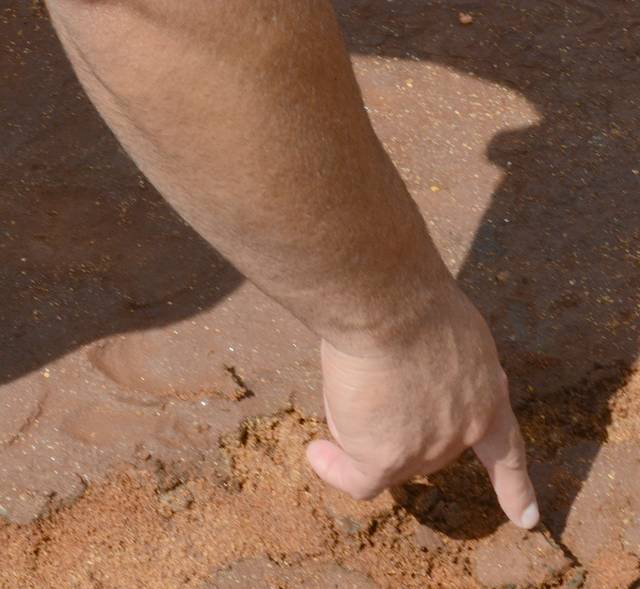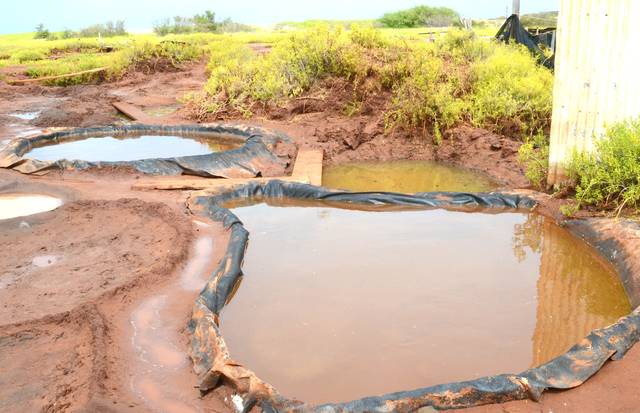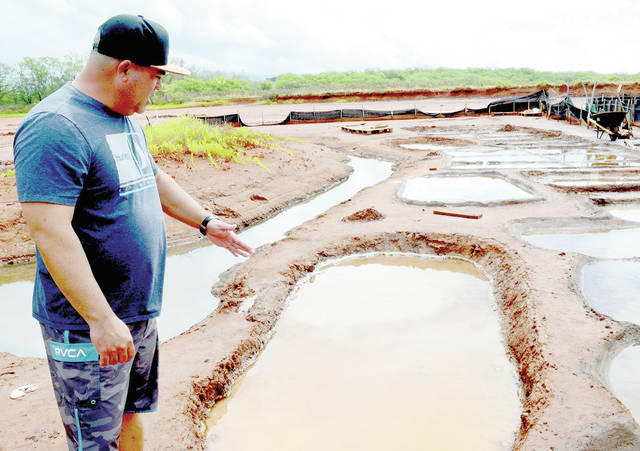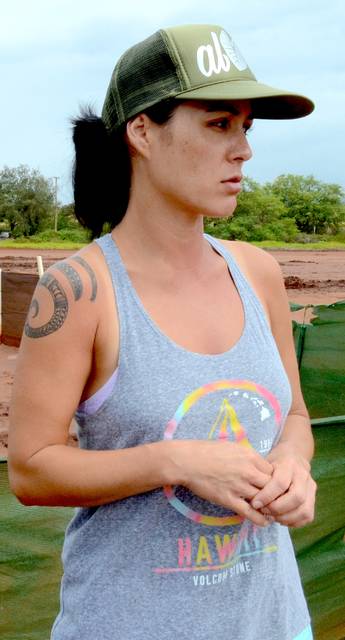For centuries, select families have harvested salt from the Hanapepe salt beds.
But with current conditions of the surrounding area and changes to the climate, salt makers are concerned this important cultural practice is threatened.
“We’re not in this for the profit. It’s the only place in the world that makes
Hawaiian salt that way,”
said Ku‘ulei Santos, vice president of the salt-makers’ board.
“You can’t buy it in a craft fair. You can’t buy it in a store,” said Santos.
Santos said her father’s generation of salt-makers was raised to just get the work done. As a result, the area around the salt beds was developed without their consideration, she said.
“They cater to everyone else without making the salt makers the most important part of that area,” she said. “They made it about the helicopter companies, they made it about the state, but they took away from paakai (salt).”
At the salt beds, U‘i Corr-Yorkman and her husband, Josh Yorkman, who also sit on the salt-makers’ board, echoed Santos’ concerns — and had some of their own.
Beachgoers are driving on the beach adjacent to the salt-making area, causing run-off, which makes it more difficult for makers to find the necessary items to make the beds, such as the black clay and salted water for the wells.
Debris from vehicles driving on the road in between the salt beds and main road is also making its way into the salt-making area.
The sand dune that sits adjacent to the salt-making area has deteriorated to the point that they can now see the ocean from the salt beds, which never used to be the case. This results in flooding of the beds when there’s a large surge or tide.
For years, the salt makers have been meeting with county and state officials regarding these issues, but it’s been frustrating because nothing is ever done, the Yorkmans said.
What they’d like to see happen, as soon as possible, is the road in between the salt-making area and the main road be closed to driving. They’d also like police to patrol the parking lot at night to cut down on the amount of people lingering there.
“We need the sand to be pushed back up, the hill to be remade so we can’t see the waterline anymore, because that’s how it used to be,” Corr-Yorkman said. “Get a machine in here, push the sand all back up, create a hill and move the boulders so that no one can drive on the sand on the right-hand side.”
If those things could be done, everyone would be much happier, she said.
“That’s the solution to all of the problems that we’re having,” Corr-Yorkman said.
Sarah Blane, County of Kauai spokesperson, said the boulders sit on land that is under the jurisdiction of the state Department of Transportation Airports Division.
HI-DOT spokesperson Shelly Kunishige said during a Friday meeting, the state Department of Land and Natural Resources Board of Land and Natural Resources approved the right-of-entry permit, which allows the county to access the area in order to help protect the salt beds.
“At the request of the families who manage this area, the county plans to move existing boulders at the beach-end of Lele Road to a more suitable location that protects the loi paakai of Ukala at Hanapepe called Salt Pond and enable a pedestrian-only access on Kaalani Road adjacent to the ponds,” Blane said.
Kauai Mayor Bernard Carvalho Jr. said the county has been working with the salt makers for a long time.
“With today’s granting of the ROE permit, the county is ready to take the necessary action to help preserve this wahi pana,” he said. “We are grateful to Ku‘ulei Santos and all of the ohana for their patience and we are looking forward to the next steps.”
The amount of people using and living at Salt Pond Beach Park, and the conditions of the bathrooms and the cesspool, are additional concerns for the salt makers.
“Facilities definitely need to be upgraded to meet the needs of all of those people — the sewer, the sewer lines, the bathroom facilities, things like that,” Corr-Yorkman said. “We’re afraid that if those things do not get taken care of and if something like an overflow or something else bad happens, that we will be totally impacted, that it will just taint our whole salt-making area.”
The administration, Blane said, has requested the council approve additional funding to install a pipeline that will take the effluent away from the leach fields to the county sewer system.
“We anticipate that request to be heard at a council hearing sometime in August,” she said.
The Hanapepe salt makers hold their craft to a high standard, because they know their ancestors were there doing the same thing, Corr-Yorkman said.
“When we come to this place, all of our ancestors are no longer here, but when we come and we walk the grounds that they walked on, we touch the same clay that they use,” she said. “A lot of the beds are original beds that have been here since our ancestors were making it, so for us, we feel them, we feel all that they worked for, feel like all of their struggles, we feel why they used to do it, we feel just everything that they had to work so hard for.”
Though they have new issues to deal with than their ancestors had, Corr-Yorkman said the practice connects them to their past.
“When we come here it makes our hearts very happy because we know that they’re here, they’re surrounding us,” she said.
•••
Bethany Freudenthal, courts, crime and county reporter, can be reached at 652-7891 or bfreudenthal@thegardenisland.com.










There’s no way on earth I’d consume salt harvested from that place. Maybe 20 years ago, but the contamination in that area now makes that salt a suicide risk. The Salt Pond beach area has become a ghetto in the evenings, and what’s with the trucks parked on the beach? Are you that fat, dumb, and lazy that you can’t walk your gear in from the parking lot 200 feet away?
No where else in the world is salt being made this way in Hanapepe, Kauai. So let’s hope it remains that way
This is not culture….this is stupid people doing stupid things.
Thanks for this article. As a visitor to your beautiful island, I try to be sensitive to local issues. I like visiting the salt ponds to watch the birds and the view and have driven on Kaalani Road in the past. I’ll avoid that on future visits because of this article!